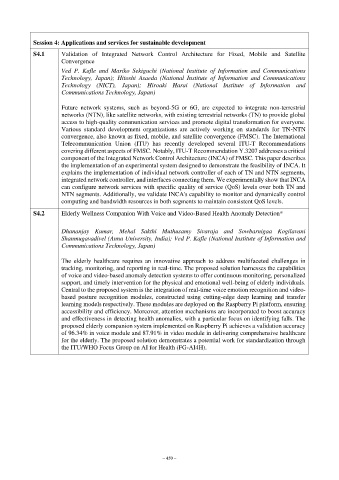Page 503 - Kaleidoscope Academic Conference Proceedings 2024
P. 503
Session 4: Applications and services for sustainable development
S4.1 Validation of Integrated Network Control Architecture for Fixed, Mobile and Satellite
Convergence
Ved P. Kafle and Mariko Sekiguchi (National Institute of Information and Communications
Technology, Japan); Hitoshi Asaeda (National Institute of Information and Communications
Technology (NICT), Japan); Hiroaki Harai (National Institute of Information and
Communications Technology, Japan)
Future network systems, such as beyond-5G or 6G, are expected to integrate non-terrestrial
networks (NTN), like satellite networks, with existing terrestrial networks (TN) to provide global
access to high-quality communication services and promote digital transformation for everyone.
Various standard development organizations are actively working on standards for TN-NTN
convergence, also known as fixed, mobile, and satellite convergence (FMSC). The International
Telecommunication Union (ITU) has recently developed several ITU-T Recommendations
covering different aspects of FMSC. Notably, ITU-T Recommendation Y.3207 addresses a critical
component of the Integrated Network Control Architecture (INCA) of FMSC. This paper describes
the implementation of an experimental system designed to demonstrate the feasibility of INCA. It
explains the implementation of individual network controller of each of TN and NTN segments,
integrated network controller, and interfaces connecting them. We experimentally show that INCA
can configure network services with specific quality of service (QoS) levels over both TN and
NTN segments. Additionally, we validate INCA's capability to monitor and dynamically control
computing and bandwidth resources in both segments to maintain consistent QoS levels.
S4.2 Elderly Wellness Companion With Voice and Video-Based Health Anomaly Detection*
Dhananjay Kumar, Mehal Sakthi Muthusamy Sivaraja and Sowbarnigaa Kogilavani
Shanmugavadivel (Anna University, India); Ved P. Kafle (National Institute of Information and
Communications Technology, Japan)
The elderly healthcare requires an innovative approach to address multifaceted challenges in
tracking, monitoring, and reporting in real-time. The proposed solution harnesses the capabilities
of voice and video-based anomaly detection systems to offer continuous monitoring, personalized
support, and timely intervention for the physical and emotional well-being of elderly individuals.
Central to the proposed system is the integration of real-time voice emotion recognition and video-
based posture recognition modules, constructed using cutting-edge deep learning and transfer
learning models respectively. These modules are deployed on the Raspberry Pi platform, ensuring
accessibility and efficiency. Moreover, attention mechanisms are incorporated to boost accuracy
and effectiveness in detecting health anomalies, with a particular focus on identifying falls. The
proposed elderly companion system implemented on Raspberry Pi achieves a validation accuracy
of 96.34% in voice module and 87.91% in video module in delivering comprehensive healthcare
for the elderly. The proposed solution demonstrates a potential work for standardization through
the ITU/WHO Focus Group on AI for Health (FG-AI4H).
– 459 –

